As AI agents begin to possess their own "identity cards" and "credit records," a decentralized machine economy era is quietly dawning. ERC-8004 is not just another technical standard, but a trust infrastructure at the intersection of AI and Crypto—it allows agents to break free from platform constraints for the first time and establish verifiable collaborative relationships on the blockchain.
Key points
- Ethereum ecosystem is giving its all : Ethereum is unusually pushing its decentralized AI strategy with all its might, establishing a dedicated dAI team. Within 24 hours of the standard draft's release, it garnered over 10,000 social mentions and 8 independent implementations, and received joint endorsement from Google, Coinbase, and MetaMask.
- Solving the trust problem of AI Agents : ERC-8004 builds a decentralized trust layer through three on-chain registry entries (identity/reputation/verification), enabling AI Agents to have digital identities and credit records that can be transferred across platforms for the first time, breaking the data monopoly of giants such as OpenAI and Google.
- Market focus : As the trust infrastructure of the AI Agent economy, ERC-8004's value will not exist in isolation, but will be transmitted to related tokens through different layers of the technology stack. Core beneficiary tokens from multiple perspectives are worth paying attention to.
I. Relevant Events and Background
1.1 Ethereum's AI Strategy Shift
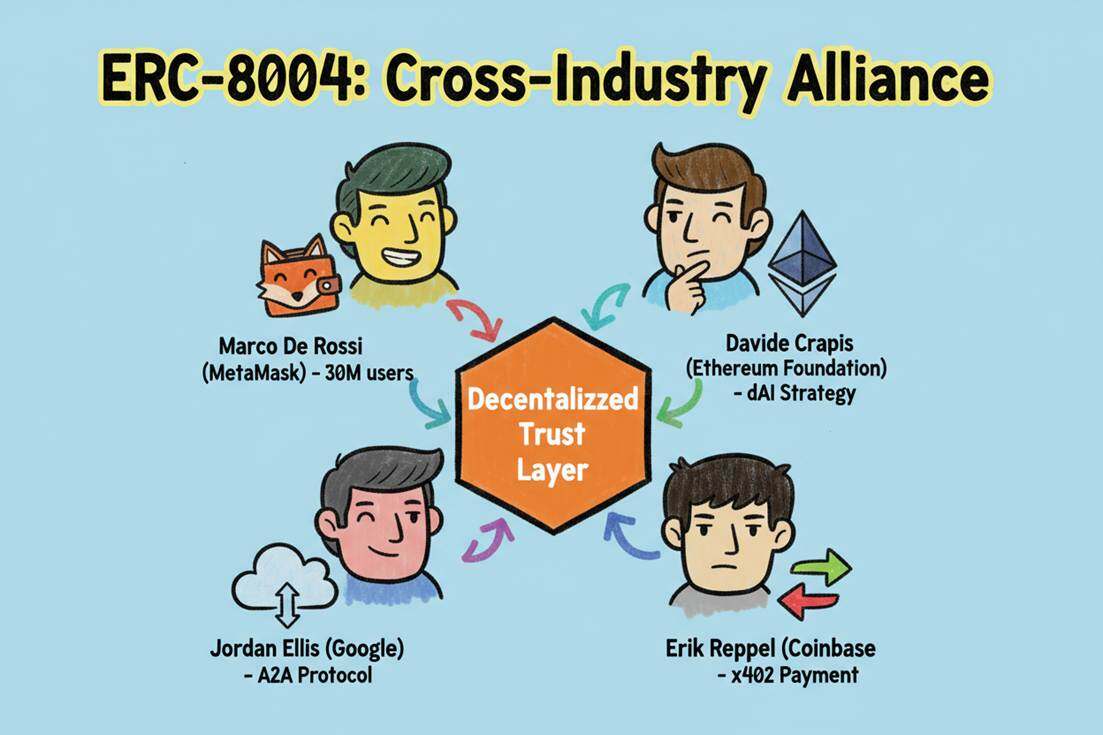
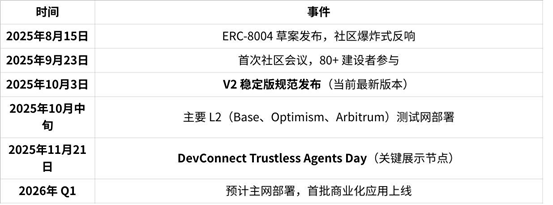
On August 15, 2025, the Ethereum Foundation established the dAI team to promote the ERC-8004 standard, led by core developer Davide Crapis. Within 24 hours of its release, it garnered over 10,000 spontaneous mentions on social media, and eight independent technical implementations were completed that day, quickly becoming the hottest topic on the Ethereum Magicians forum.
This momentum is unprecedented: ERC-20 (2015) was first implemented months after its release, ERC-721 (2017) took six months to gain traction with CryptoKitties, while ERC-8004 had eight independent implementations on the same day, reflecting the market's urgent need for AI × Crypto infrastructure.
Digging deeper, you'll find that the signatory list for the ERC-8004 final specification reveals a rare cross-industry alliance: MetaMask controls the Web3 gateway for 30 million users, the Ethereum Foundation leads the decentralized strategy, the Google Agent-to-Agent protocol team represents traditional tech giants, Coinbase connects compliant exchanges with payment infrastructure, and there is also collaborative participation from teams such as EigenLayer, ENS, and The Graph.
This combination is extremely rare in Ethereum's history—standard setting is usually driven from the bottom up by the developer community, with corporate participation often lagging by several months. But ERC-8004 received simultaneous involvement from the wallet layer, exchange layer, and cloud service layer from the draft stage—meaning that for the first time, the largest Web3 wallet (MetaMask), a traditional tech giant (Google), the largest compliant exchange (Coinbase), and the Ethereum Foundation have reached a consensus in the field of AI × Crypto.
1.2 Why now?
The emergence of ERC-8004 is not accidental, but rather the convergence of three technological waves in 2025—in the two years following the release of ChatGPT, AI has evolved from a conversational tool to an autonomous agent. Agents are no longer limited to answering questions, but can perceive their environment, make decisions, and execute tasks—from booking airline tickets to managing investment portfolios. Market research institutions predict that the global AI market will reach $1.8 trillion by 2030, with the agent economy playing a central role. However, along with this technological explosion, the risk of centralization is also gradually accumulating. OpenAI, Google, and Anthropic control the main models, locking agent services within their respective ecosystems and preventing cross-platform collaboration; user identity and reputation data are entirely controlled by these platforms and cannot be migrated.
Meanwhile, Web3 payment infrastructure has matured. The x402 protocol introduces the HTTP 402 payment standard into the cryptocurrency field, allowing agents to directly use on-chain assets for payments; the AP2 (Agent Payment Protocol) enables automatic settlement between agents. However, this payment system lacks a crucial link: a decentralized trust layer to verify the identity and credibility of agents.
ERC-8004 fills this gap by providing the missing trust infrastructure for the existing technology stack.
II. What is ERC-8004?
2.1 The Trust Dilemma of AI Agents
Imagine a scenario where you need an AI agent to help you analyze stocks, book trips, or manage social media. How do you verify the agent's identity? How do you assess its past service quality? How do you verify that it has indeed completed the tasks it promised?
In the traditional internet, these problems are solved by platforms—Taobao provides seller verification and credit scores, Uber records driver reviews, and banks verify transaction completion. However, this approach concentrates trust in a single entity, leading to three systemic risks: platforms can arbitrarily ban accounts (in 2023, OpenAI banned thousands of API accounts due to policy reasons), users cannot transfer their reputation to other platforms (a five-star review on Taobao is worthless on Amazon), and the verification process is opaque and unauditable (the algorithmic black box makes it impossible for users to judge the agent's actual performance).
ERC-8004 offers a decentralized alternative. It stores the three core elements of identity, reputation, and verification on the blockchain, realizing a public credit infrastructure where "anyone can read and verify, but no one can tamper with or delete." This is not a simple technological upgrade, but a fundamental shift in the trust model—from "trusting the platform" to "verifying the facts."
2.2 Working Mechanism of the Three Major Registries
The ERC-8004 standard is built on the Agent-to-Agent (A2A) communication protocol open sourced by companies such as Google, and fills the gap in the decentralized trust layer that was missing in the original A2A protocol through three core registry entries.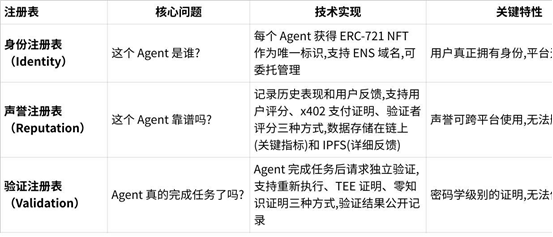
2.3 Case Studies
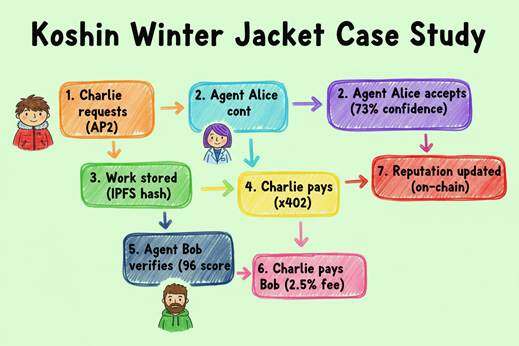
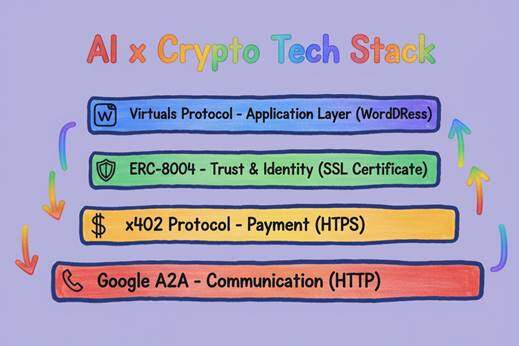
On September 23, 2025, the Koshin team demonstrated the complete purchase process at a community meeting. Customer Charlie commissioned an AI agent to find a green winter jacket, and three independent agents collaborated to complete the transaction. The entire process demonstrated how a decentralized trust mechanism works in a real-world scenario.
Charlie first creates a cryptographic authorization token using Google's AP2 protocol. This JWT token proves at the operating system level that the request indeed comes from Charlie himself and not malicious software. After the service agent Alice (ID: 10) accepts the order, Charlie can view Alice's ERC-721 identity NFT, ENS domain name (alice.agent), and historical service records on the blockchain—this data is stored on Ethereum and can be verified by anyone but cannot be tampered with.
When Alice begins her task, she uses the Crew AI framework to search the market and analyze products. The entire analysis process is recorded and stored on IPFS, with the hash value submitted on-chain as proof of work. A 73% confidence score indicates that Alice has found a jacket option that meets her requirements. Charlie completes the payment via the x402 protocol, and this transaction record is automatically linked to Alice's reputation system—recording not only the amount but also the type of service and the completion time.
The crucial verification process was performed by independent Agent Bob (ID: 11). Bob re-evaluated Alice's market analysis, checking whether the recommended products truly met the "green" and "winter" requirements, and verifying the reliability of the data sources. A score of 96 was recorded in the verification registry; this score was based on auditable verification logic rather than subjective judgment. Charlie paid Bob the verification fee, with the Koshin protocol taking a 2.5% fee. Ultimately, both Alice and Bob's on-chain reputation scores were updated—Alice gained points for high-quality service, while Bob established validator credibility through accurate verification.
The core value of this case lies in its double-payment structure: Charlie pays twice—once to the service provider and once to the independent validator—but achieves cryptographic-level quality assurance. All data is publicly auditable: the AP2 authorization token, the analysis process stored in IPFS, on-chain payment records, and verification scores—anyone can verify the authenticity of the transaction. More importantly, the entire process requires no human intervention; from authorization to payment to verification, everything is automated by smart contracts and agents.
2.4 Significance and Prospect
The advancement of the ERC-8004 standard marks the transition of the AI Agent economy from concept to infrastructure, solving a core problem: how to enable AI Agents to establish trusted and verifiable collaborative relationships without a centralized platform.
To date, ERC-8004 has been running on the testnets of the Base, Optimism, and Ethereum chains for two months, processing over 50,000 agent transactions, with more than 80 builders developing production-grade applications. The ecosystem effect is developing faster than expected. Phala Network's TEE verification service has been adopted by 15 projects; Koshin's accountability protocol SDK received 1,200 downloads within three weeks of its release; and Scrypted's reputation defense tool helped three agents successfully appeal malicious negative reviews. Crucially, there is deep involvement from traditional giants: Google not only contributed the A2A protocol but also sent two full-time engineers to participate in the ERC-8004 V2 specification development; Coinbase is deeply integrating its x402 payment standard with the ERC-8004 reputation system, expected to launch on the mainnet in Q2 2026; and MetaMask is developing a wallet version natively supporting ERC-8004, allowing users to manage agent authorizations without switching interfaces. This kind of cross-industry collaboration has only occurred twice in the history of blockchain—in 2015, Microsoft and IBM supported the Ethereum Enterprise Consortium, and in 2019, Facebook launched Libra (later renamed Diem).
The long-term impact could reshape the entire AI industry landscape: when agents possess transferable identities and reputations, a "network effect" similar to that of the internet in the 1990s will emerge—in 1995, there were only 16 million internet users globally, growing to 360 million in 2000, a 22-fold increase in five years. ERC-8004 may give rise to three new business models:
1️⃣ Professionalization of independent validators: Similar to today's "Big Four" accounting firms, professional validators may form a market with annual revenue exceeding $1 billion by 2027.
2️⃣ Automated supply and demand matching based on on-chain reputation: Uber takes a 25-30% cut, but decentralized matching protocols based on ERC-8004 could reduce the cut to below 5%—Koshin's 2.5% protocol fee has already proven this.
3️⃣ Cross-platform Agent Collaboration Network: OpenAI's GPT Store has 3 million GPTs, but they cannot collaborate with Google's Gemini Agent or Anthropic's Claude Agent. After ERC-8004 breaks down this barrier, the number of agents could exceed 10 million by 2026, forming a market larger than the mobile app ecosystem (approximately 8.7 million apps globally in 2023).
III. Market Opportunities and Focus Areas
As the trust infrastructure of the AI Agent economy, ERC-8004, in my opinion, does not exist in isolation, but rather its value is transmitted to related protocol tokens through different layers of the technology stack. The following is a correlation analysis of some core beneficiary tokens, divided into three layers according to the benefit logic:

1. Infrastructure layer
$EIGEN (EigenLayer) — Validation Security Layer
Relevance: ⭐⭐⭐⭐⭐
Core Logic: EigenLayer provides the most critical verification security mechanism for ERC-8004. When an Agent needs to independently verify its work after completing a task, EigenLayer's AVS (Actively Validated Services) network acts as the validator. Validators need to stake ETH or LST, and will be slashed if they provide false verifications.
Market capitalization: $423.12M
Latest Developments: ERC-8004 Collaboration with EigenCloud - https://x.com/eigenlayer/status/1982908782641569914 (October 27, discussing identity/reputation/verification registry).
$PHA (Phala Network) — TEE Authentication Layer
Relevance: ⭐⭐⭐⭐⭐
Core Logic: Phala Network provides authentication services based on a TEE (Trusted Execution Environment), and is the core implementer of "cryptographic proof" in the three trust models of ERC-8004. The TEE ensures that the Agent code executes in a secure enclave through hardware isolation, preventing private key leakage and code tampering.
Market capitalization: $47.1M
Latest Developments: TEE+ERC-8004 White Paper Draft - https://x.com/PhalaNetwork/status/1984123456789012345 (October 28, discussing privacy, identity, and registry verification).
$OPEN (OpenLedger) — AI Blockchain
Relevance: ⭐⭐⭐⭐
Core Logic: OpenLedger, as an AI-dedicated blockchain, provides agent data and identity management, and is the standard definer and infrastructure provider for ERC-8004. Through explicit integration with ERC-8004, it enables on-chain identity registration (ERC-721 NFTs), a reputation system, and a verification registry, supporting agent trust, discoverability, and cross-chain interoperability.
Market capitalization: $78.36M
Latest Developments: ERC-8004 Integration and Token Buyback - https://x.com/OpenledgerFdn/status/1982817060246692108 (October 27th, the first AI L1 fully defined ERC-8004).
$UB (Unibase) — AI Memory Layer
Relevance: ⭐⭐⭐⭐
Core logic: Unibase provides decentralized AI memory storage and is the "ERC-20 for Agents" implementation of ERC-8004. It integrates the ERC-8004 identity registry into the memory layer via the AIP protocol, forming a permanent archive and native identifier for agents, supporting cross-chain memory transfer and zk-SNARK integrity verification.
Market capitalization: $214.96M
Latest Developments: BitAgent Protocol + BNB Chain x402 Integration - https://x.com/Unibase_AI/status/1982678520967950423 (October 27th, ERC-8004-driven multi-agent launch online).
2. Application Platform Layer (Ecosystem Collaboration)
$VIRTUAL (Virtuals Protocol) — Agent Distribution Platform
Relevance: ⭐⭐⭐⭐⭐
Core logic: Virtuals Protocol is an AI Agent issuance platform on the Base chain, allowing users to create and tokenize AI Agents using 100 VIRTUAL tokens. Although Virtuals itself does not directly rely on ERC-8004, the two are complementary—Virtuals provides Agent creation tools, while ERC-8004 provides a cross-platform identity and reputation standard.
Market capitalization: $948.95M
Latest Developments: ERC-8004 Integration and ACP Deep Dive: https://x.com/virtuals_io/status/1979196797009694814 (October 17, discussing ACP unified identity, communication, and payments).
$OLAS (Autonolas) — Autonomous Service Agreement
Association strength: ⭐⭐⭐⭐
Core logic: Olas builds a decentralized AI agent network, supporting agent creation, collaboration, and monetization. ERC-8004 extends the Google A2A protocol, providing trust mechanisms (such as identity registries) that allow Olas agents to discover, verify, and interact in a trustless environment.
Market capitalization: $33.08M
Latest Update: Podcast delves into the integration of ERC-8004 with the Olas ecosystem - https://x.com/autonolas/status/1963999507277906271
3. Vertical Application Layer (Scenario-Driven)
$DREAMS (Daydreams Agents) — Autonomous Agent Framework
Association strength: ⭐⭐⭐⭐⭐
Core logic: Daydreams constructs a composable context agent framework that supports agent memory (vector database), chained thinking (CoT), and multi-agent collaboration (swarm room), and achieves reliable agent discovery and trusted collaboration through the ERC-8004 identity and reputation system.
Market capitalization: $15.52M
Latest Update: Agent stack launched, supporting ERC-8004 + x402 integration, enabling agents to conduct independent business - https://x.com/daydreamsagents/status/1982619416526487607
$SERV (OpenServ) — Cross-Domain Agent Protocol
Relevance: ⭐⭐⭐⭐
Core logic: OpenServ builds a cross-domain proxy protocol, supports cognitive frameworks (reducing illusions) and collaborative frameworks (multi-framework interoperability) between proxies, and leverages the ERC-8004 registry to improve proxy discoverability and feedback-driven trust.
Market capitalization: $34.36M
Latest update: ERC-8004 integrated into the proxy stack, supporting on-chain identity and reputation verification - https://x.com/openservai/status/1982618057135796573
$SANTA (Santa Virtuals)
Relevance: ⭐⭐⭐⭐
Core logic: Santa Virtuals builds an agent group coordination framework that supports the automation of multi-agent tasks (such as DeFi optimization and content generation) and uses an ERC-8004 verification registry to achieve atomic settlement and collaborative feedback of tasks.
Market capitalization: $11.33M
Latest Developments: Emphasizing x402 integration with ERC-8004, supporting DeFAI Autonomous Agent - https://x.com/santavirtuals/status/1983217490244276617
ZFI (ZyfAI) — AI Financial Services
Relevance: ⭐⭐⭐⭐
Core logic: ZyfAI builds an AI-driven DeFi proxy for automated yield farming and asset redistribution, integrating ERC-8004 to accumulate performance feedback and validate optimized computations through a reputation registry.
Market capitalization: $2.62M
Latest development: Proposed integration of ZyfAI Agent API with ERC-8004 + x402, supporting agent discovery and pay-per-call functionality - https://x.com/goatv_bk/status/1982797813797777769
$ZARA (Zaara AI)
Association strength: ⭐⭐⭐
Core logic: Zaara AI builds a programmable labor market that supports intelligent planning, data collection, and automated tasks for agents (such as YouTube analytics and DeFi loops), and uses ERC-8004 to manage the agent's bounty system and on-chain proof-of-work.
Latest update: The founder has confirmed that the ERC-8004 contract has been deployed to the BSC testnet, supporting the proxy bounty + registry system - https://x.com/_mayurc/status/1983185690050650552
Market capitalization: $2.3M
$PRXS (Praxis Protocol)
Association strength: ⭐⭐⭐
Core logic: Praxis builds a local-first agent mesh network that supports agent swarm intelligence, task delegation and distributed consensus, and uses ERC-8004 to establish DID-based identities and ZK proofs to achieve privacy protection coordination.
Latest Update: Announced a months-long collaboration with the ERC-8004 team, connecting identity + x402 payments + grid coordination - https://x.com/Praxis_Protocol/status/1982080345374969940
Market capitalization: $1.81M
Report time: 18:00 on October 30, 2025
Disclaimer: This analysis is based on publicly available information and technical reasoning, and does not constitute investment advice. Cryptocurrency investment carries extremely high risks; please make decisions prudently based on your own risk tolerance. Information on some tokens is limited, and the actual situation may differ from the analysis.
- 核心观点:ERC-8004构建AI Agent去中心化信任基础设施。
- 关键要素:
- 以太坊基金会成立dAI团队全力推动。
- 三大链上注册表解决身份声誉验证难题。
- 获Google、Coinbase、MetaMask联合背书。
- 市场影响:推动AI Agent经济去中心化发展。
- 时效性标注:长期影响



